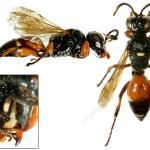Previously classified in the genera Alysson and Dienoplus. A small red and black wasp, typically with a white scutellum and three white spots on the abdomen rendering it distinctive. Usually encountered in dry sandy locations where it is a frog-hopper predator.
Recorded widely but sparingly across England and Wales, and extending as far north as Grantown, Elgin in Scotland. Also the Channel Islands (Jersey and Guernsey) and a few sites in Ireland (Waterford, Wexford and Wicklow). A southern bias is exhibited and most records are concentrated within coastal districts or heathy districts inland. Local in southern England, becoming very scarce in the northern part of its range, though with a cluster of recent records in Yorkshire through the efforts of M E Archer. It is rarely common anywhere, though it is easily overlooked. Overseas, it is widely reported from north and central Europe; also southern Siberia and Japan (Lomholdt, 1975-76).
This species is not regarded as being scarce or threatened.
Recorded from heathland, coastal dunes, coastal landslips, open areas in woodland, sandpits, embankments and cuttings. Within these locations, it is usually observed running rapidly over the ground or low vegetation in sparsely vegetated or short-cropped areas fully exposed to the sun. Females are likely to require taller herbage nearby for hunting.
Univoltine; exceptionally from late May, but normally from mid-June to mid-September. Nesting biology and prey collected Nests are excavated in dry sandy soil and consist of several cells at the end of a short tunnel. Individual cells are stocked with 5 or 6 frog-hoppers, such as Philaenus and Aphrodes species; both adults and nymphs being used. The female closes the nest entrance with sand between hunting trips. (Hamm & Richards, 1930; Lomholdt, 1975-76).
Umbellifers such as wild carrot and wild parsnip.
The nyssonine wasp Nysson dimidiatus and chrysidid wasp Hedychridium roseum. Additional Nysson species attack H. tumidus abroad.
2001


